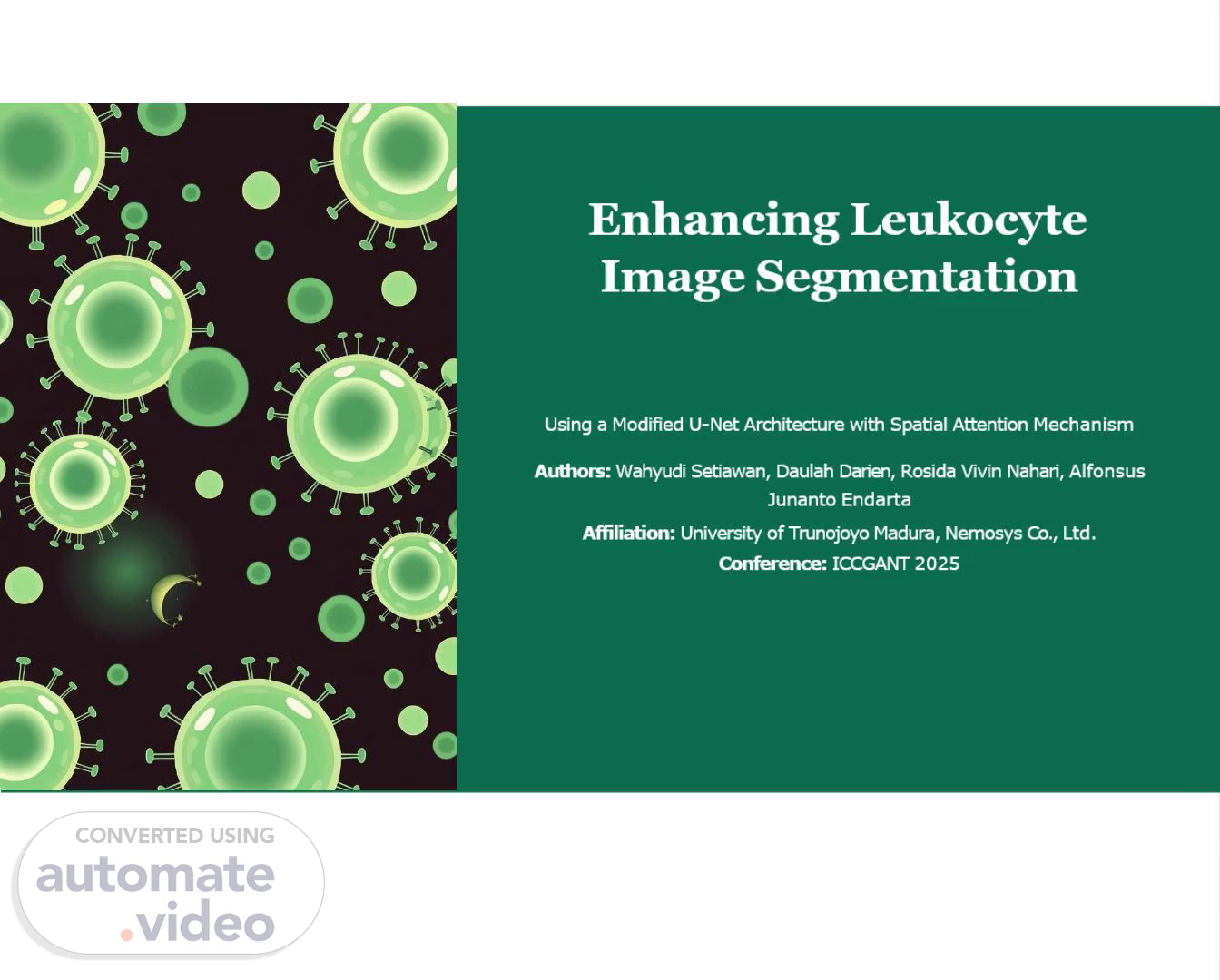Scene 1 (0s)
[Audio] Enhancing Leukocyte Image Segmentation Using a Modified U-Net Architecture with Spatial Attention Mechanism Authors: Wahyudi Setiawan, Daulah Darien, Rosida Vivin Nahari, Alfonsus Junanto Endarta Affiliation: University of Trunojoyo Madura, Nemosys Co., Ltd. Conference: ICCGANT 2025.
Scene 2 (28s)
[Audio] The Crucial Role of Medical Image Segmentation Image Segmentation A crucial process in medical image analysis, enabling precise identification of structures. Leukocyte Indicators Leukocytes are key indicators for disease diagnosis, making their accurate analysis vital. Complex Boundaries Segmenting nucleus and cytoplasm is particularly challenging due to their intricate and complex boundaries..
Scene 3 (59s)
[Audio] Addressing the U-Net's Spatial Detail Čap Standard U-Net Limitations While widely used for semantic segmentation in medical imaging, the standard U-Net often fails to capture fine spatial details, limiting its precision. Spatial Attention Enhancement Incorporating a Spatial Attention mechanism can significantly enhance feature representation, allowing the model to focus on critical regions and improve detail capture..
Scene 4 (1m 26s)
[Audio] Our Core Research Objectives f Improve Segmentation Accuracy To significantly enhance the accuracy of leukocyte image segmentation, particularly for challenging nucleus and cytoplasm boundaries. 2 Evaluate Effectiveness To rigorously evaluate the effectiveness of our modified U-Net with Spatial Attention compared to the performance of the standard U- Net architecture..
Scene 5 (1m 51s)
[Audio] Comprehensive Datasets for Training Raabin-WBC Background, Nucleus, Cytoplasm 1,145 images 300 images Cella-Vision Background, Nucleus, Cytoplasm Both datasets provide ground truth annotations across three critical classes: background, nucleus, and cytoplasm, essential for supervised learning..
Scene 6 (2m 17s)
[Audio] Methodology: Building Our Enhanced Model Dataset Preprocessing Initial steps involved thorough dataset preprocessing to ensure consistency and optimal quality for model training. Base Model: U-Net We utilized the robust U-Net architecture as our foundational base model for image segmentation. Spatial Attention Integration A key modification was the seamless integration of Spatial Attention into the U-Net's encoder-decoder structure..
Scene 7 (2m 50s)
[Audio] Methodology: Optimizing Model Training Training Setup Parameters Optimizer: Adam Learning Rate: 0.0001 Batch Size: 8 Robust Regularization Strategies Learning rate reduction to fine-tune convergence. Early stopping to prevent overfitting and optimize training time. Cross-validation for robust model evaluation and generalization..
Scene 8 (3m 17s)
[Audio] Breakthrough Results: Enhanced Performance 0. 9435 Average Evaluation Score Our modified U-Net achieved an impressive average evaluation score, demonstrating superior performance. Significant Outperformance The U-Net with Spatial Attention significantly outperforms the standard U-Net across all metrics. Higher Accuracy & Robustness It demonstrates consistently higher accuracy and robustness in all tested scenarios, validating our approach..
Scene 9 (3m 51s)
[Audio] Key Insights: The Power of Spatial Attention Enhanced Focus Spatial Attention effectively enhances the model's focus on relevant cellular structures, particularly nucleus and cytoplasm. Improved Čeneralization The enhanced model exhibits improved generalization capabilities across diverse medical image datasets. Wider Application Potential This approach holds significant potential for broader application in various medical image segmentation tasks beyond leukocytes..
Scene 10 (4m 24s)
[Audio] Conclusion & Future Directions Key Conclusion The integration of Spatial Attention is highly effective in boosting U-Net performance, leading to significant improvements in medical image analysis. Future Work Explore the use of even larger and more diverse datasets. Investigate integration with other advanced attention mechanisms. Apply the methodology to other challenging medical imaging modalities..
